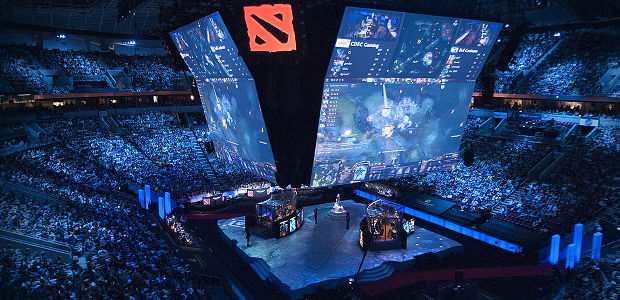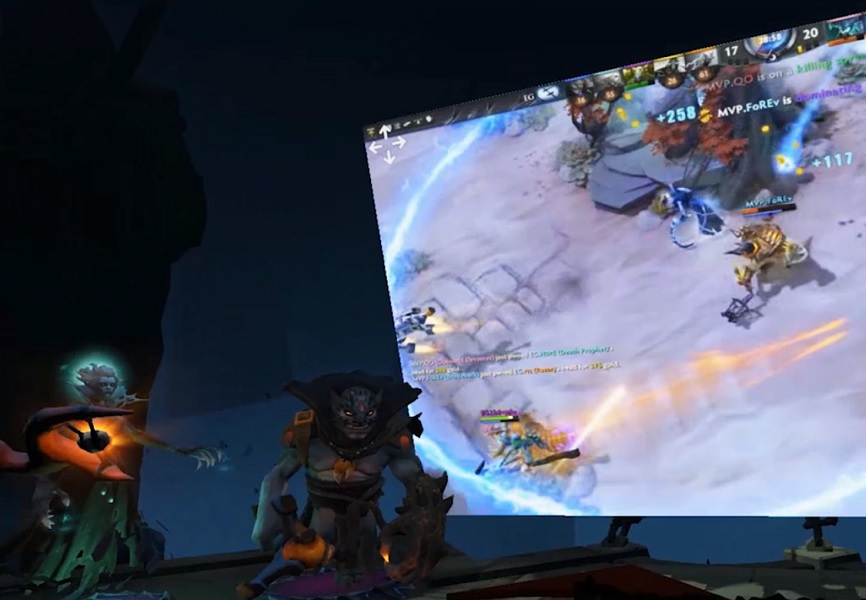Dota 2 VR Is a Taste of Esports' Immersive Future
With Dota 2's VR spectator mode, Valve is showing how virtual reality will take esports to a whole new level.

If you want to get the best, most immersive sports spectating experience, you typically need to shell out thousands of dollars for front-row tickets. And unless you're Spike Lee or Jack Nicholson, getting the seats you really want is little more than a pipe dream. But when it comes to e-sports, there's a new technology that will put the best place to watch video games right in your house and make courtside seats seem boring. It's called virtual reality.
The most exciting example of this is Valve's VR spectator mode for Dota 2. It's a bespoke VR environment designed specifically to provide you with a viewing experience not possible in any other medium. This spectator mode has been out for a little while, but with the biggest e-sports tournament ever going on right now in Seattle at The International 2016, now's the perfect time to check out how a prize of over $20 million is going to get split up in VR.
MORE: Oculus Rift vs. HTC Vive: The Vive Is Better (for Now)
After picking a match to watch, you get launched into a virtual hall featuring a theater-size 2D view of a match, with the current heroes for both teams flanking your left and right and, most importantly, an interactive map set in the middle of the floor.
But the map isn't just a map; it's a gateway to the action. By pressing a button on an HTC Vive controller, you can teleport from the coliseum-like viewing hall directly into the game, where you can move and hover across the map, watching the action as it plays out in front of your eyes.
So instead of the traditional top-down view, you get a true 3D look at Lina blowing up opponents with a well-timed Laguna Blade, or the cry of a support hero who just got hooked from across the river by Pudge. It's the true definition of immersion; the only way things could get any more realistic is if you were the heroes throwing fireballs across the map.
In addition to freely exploring the battle, you can teleport to wherever the game's commentators are looking, meaning you're never more than one click away from the action. And because you can still hear the full match commentary, the adrenaline pumping through your body during big plays is more intense than ever.
Oh, and I wasn't the only one in the room, either. Because just like a real sports game, there were other fans with me, watching Evil Geniuses take on Newbee during The International. Other spectators showed up as floating heads with pairs of Vive controllers drifting around them.
Some of those heads were sporting masks of pro Dota players such as Dendi, while others were wearing busts from Dota heroes such as Anti-Mage and Treant Protector. And every time there was a big fight, all of the disembodied dome pieces gathered around like moths to a flame, which added even more hype to the already electrifying experience.

While Valve's VR spectator mode could benefit from more polish and higher-resolution headsets, it makes me want to spend $800 on a Vive more than any VR game currently on the market.
Although the Dota 2 VR spectator mode is the first of its kind, the future looks even brighter when I think about what this could do for other games. Imagine if you could watch Street Fighter V tournaments from the tarmac on Guile's Air Force base, or at Union Station, watching as Chun-Li punches M. Bison in the gut before finishing him off with a spinning kick that flies past your face.
Or how about Overwatch? Instead of clicking between player perspectives, you could sit on the payload as a Winston pops his ultimate and smacks the defending team away like a set of bowling pins. Or, you could fly over the whole map to get a real 6v6 view akin to the NFL's vaunted All-22 view.
The possibilities are endless, and none of them could be achieved in real life. Valve has given us a glimpse of what can be done, and although it might be hard to develop, I’m hoping other developers like Riot, Blizzard and Capcom have taken notice. And after seeing it in action during a tournament with a prize pool of over $20 million, I'm sure that this look into our VR-powered future is what will take e-sports to a whole new level.
Sign up to get the BEST of Tom's Guide direct to your inbox.
Get instant access to breaking news, the hottest reviews, great deals and helpful tips.
Sam is a Senior Writer at Engadget and previously worked at Gizmodo as a Senior Reporter. Before that, he worked at Tom's Guide and Laptop Mag as a Staff Writer and Senior Product Review Analyst, overseeing benchmarks and testing for countless product reviews. He was also an archery instructor and a penguin trainer too (really).
